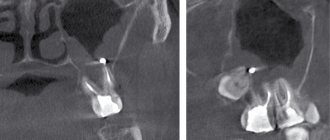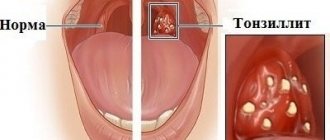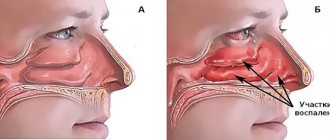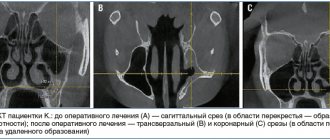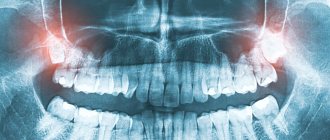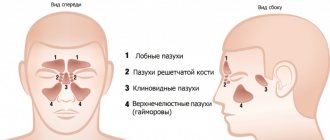Nasal hemangioma and other benign tumors of the nose
Benign nasal tumors are formed from various tissues present in the nose and paranasal sinuses. Hemangioma is a benign tumor that most often develops in the first days of a child’s life and actively grows in the first six months of his life. After the child is one year old, the tumor begins to involute; most of the hemangiomas disappear by the age of seven, the rest by the age of twelve. More often, hemangiomas form in girls. The cause of the disease is a disturbance in the development of blood vessels in the embryonic period. Nasal hemangioma can grow deep into the skin, tissues of the organ and to the sides, destroy tissues, provoke bleeding, and disrupt the functions of the organ.
Nasal fibroma is a benign formation that can spread to the orbit. Nasal fibroma is rare, characterized by active growth and quickly grows into the orbit and paranasal sinuses. The tumor causes nosebleeds and nasal congestion. Fibroma that has grown into the orbit and nasal sinuses causes various complications: constant lacrimation, decreased visual acuity, exophthalmos, and can cause deformation of the skull bones. Fibroids rarely develop in the paranasal sinuses, most often developing in the maxillary sinus.
Adenomas in the nose can be true adenomas, a papilloma-like tumor, or a malignant destructive adenoma. Adenomas do not produce secretions, despite the fact that the tumor contains glandular epithelium. Adenomas in the nose are rare and are characterized by nosebleeds, nasal congestion, and can lead to the development of exophthalmos, purulent dacryocystitis and other complications.
Benign neoplasms of the nose are osteoma, chondroma, angioma, papilloma, chordoma, lipoma, myxoma, bleeding polyp, ganglioneuroma, dermoid cyst and other neoplasms. Tumors are formed during intrauterine development of the fetus with a negative impact on the woman’s body during pregnancy. They can appear in chronic diseases of the nasopharynx; the appearance of tumors is influenced by poor environmental conditions, injuries, and infections.
2. Reasons
Erysipelas is a bacterial infection, the causative agent of which is almost always group A beta-hemolytic streptococci. This tendency, however, is not absolute: a similar inflammation can be caused by staphylococcus, especially in cases of a long-term chronically recurrent process, as well as other pathogens. In general, we have to take into account the fact that in recent decades in the clinic of infectious diseases, incl. skin, there is a steady tendency towards an increase in combined invasions (for example, bacterial and fungal), developing according to the mechanism of super- or coinfection.
The main risk factor is microtraumatization of the skin of the nose in combination with weakened local immunity and non-compliance with sanitary and hygienic rules.
The risk increases in the presence of foci of chronic coccal infection in adjacent tissues and organs (otitis, tonsillitis, sinusitis, and many others). One of the widespread causes of erysipelas is the practice of self-squeezing out elements of acne and/or pustular (pustular) rash in unsterile or frankly unsanitary conditions. In some cases, nasal erysipelas is iatrogenic in nature, i.e. the launch of the pathological process is caused by medical procedures or surgical intervention on the ENT organs.
Visit our Otolaryngology (ENT) page
Cancer of the nose and paranasal sinuses: symptoms
A tumor in the nose develops in the maxillary sinus (maxillary sinus cancer), and cancer also affects the nasal cavity. Nasal cancer, the symptoms and signs of which become pronounced at a late stage, accounts for 1.5% of all cancers; men are more often affected. The reasons for the development of the disease are not fully known; most often, nasal cancer develops in workers of nickel production enterprises, woodworking and leather industries, in people who smoke and who often suffer from nasal infections. Symptoms and signs of nasal and sinus cancer vary. At the initial stage of development, the symptoms are similar to those of various diseases - rhinitis, sinusitis and other disorders.
Then the patient begins to experience headaches, discomfort, pain in the sinuses, and a change in sense of smell. The nose is constantly stuffy, mucous discharge from the nose bothers me. The pain can radiate to the upper jaw, temple, and a constant severe headache - such symptoms develop with cancer of the maxillary sinuses.
Cancer of the posterior external part of the maxillary sinus is manifested by difficulty while eating, difficulty opening the mouth - the cancer grows into the masticatory muscles. Cancer of the anterior lower part of the maxillary sinus often affects the hard palate and upper jaw, leading to tooth loss and the appearance of wounds on the gums. Cancer of the nose and paranasal sinuses can lead to displacement and loss of the eye, and facial deformation.
Squamous cell carcinoma is the most common type of cancer; adenoid cystic carcinoma, adenocarcinoma, poorly differentiated transitional cell carcinoma, olfactory esthesioneuroblastoma and melanoma are less common. Carcinoma of the nose is not as dangerous as cancer of the paranasal sinuses, which has a less favorable prognosis. If early stage cancer is detected on the nose, then the five-year survival rate of patients is more than 50%, for cancer of the paranasal sinuses it is no more than 25%. Sinosanal poorly differentiated carcinoma has an aggressive course - the tumor affects the paranasal sinuses and nose, and is characterized by the appearance of ulcers and a tendency to necrosis.
Cancer of the nose and paranasal sinuses has clinical manifestations depending on the location of the tumor. Often a tumor in the thickness of the alveolar process is mistaken for an inflammatory process. It manifests itself in growth after tooth extraction. It is very difficult to differentiate tumors from the upper internal sinus. A tumor of the upper outer part of the maxillary sinus can remain unrecognized for a long time and manifest clinical symptoms in the form of pain. A tumor that has grown into the orbital area is manifested by swelling of the lower eyelid. A tumor that affects the infratemporal fossa, pterygopalatine fossa leads to swelling of the eyelid, the development of chemosis with exophthalmos.
1.General information
Erysipelas, erysipelas - these and similar terms are used mainly in Slavic languages; in medical Latin and most Western European languages, the original ancient Greek name erysipelas was fixed, i.e. "red skin" In the old days there were also synonyms “holy fire”, “Saint Anthony’s fire” or, in Russian, “Antonov’s fire”, although some dictionaries define this term as one of the designations for gangrene.
Erysipelas is an acute skin infection (or recurrent exacerbation of a chronic one), the hallmarks of which are swelling and erythema - a bright red, “fiery” hue of the affected area. In general, erysipelas is one of the most common human infectious diseases; the localization of inflammation can be very different, however, due to the peculiarities of the anatomical structure, the disease often manifests itself on the skin of the face, primarily in the soft tissues of the external nose (vestibule, wings, nasal walls): a high concentration of sebaceous glands, capillaries and nerve endings facilitates the penetration and activation of the pathogen .
A must read! Help with treatment and hospitalization!
Nasopharyngeal cancer
With a tumor of the nasopharynx, the symptoms of the disease can be widespread and less common. Early manifestations of nasopharyngeal cancer are nasal congestion, a burning sensation in the throat, swollen lymph nodes, and ear congestion. The symptoms are similar to those of a cold. The tumor begins to progress rapidly and is manifested by the following symptoms: nosebleeds, hearing loss, sore throat, nasal congestion, frequent headaches, enlarged cervical lymph nodes, squint on one side, a feeling of numbness in the face, difficulty opening the mouth, non-healing in the nasopharynx. wounds.
Nasopharyngeal cancer is dangerous because the disease is asymptomatic in the early stages of development. Very often, the symptoms of cancer resemble the symptoms of colds. When oncology of the nasopharynx is detected, the symptoms most often indicate a late stage of cancer - an unpleasant putrid odor appears from the mouth, the patient feels an unpleasant odor that comes from the nasal sinuses, headaches are tormented, the vocal cords swell, the voice changes, the patient has difficulty swallowing, opening the mouth.
Nosebleeds are a constant concern, the body temperature periodically rises, tachycardia worries, speech becomes incoherent, strabismus and paralysis of the facial nerves may develop. Stage 4 nasopharyngeal cancer is characterized by general weakness, severe symptoms, severe pain in the nasopharynx, neck, and headaches.
Treatment
Pre-hospital assistance
Patients with a tendency to develop swelling of the nasal mucosa are advised to refrain from contact with strong-smelling substances, install an air humidifier, wear a hat in winter, and avoid swimming in cold ponds and pools. Patients with allergic reactions should, if possible, avoid contact with allergens and, if necessary, take antiallergic medications. For short-term swelling, you can use vasoconstrictors yourself. In case of persistent swelling, you need to consult a specialist.
Conservative therapy
For the treatment of diseases accompanied by swelling of the nasal cavity, the following methods are recommended:
- Adrenergic agonists
. To ease breathing, they are prescribed in the form of drops and used for 1 or 2 weeks. Long-term use is undesirable, as it can lead to the development of vasomotor rhinitis. - Antiallergic drugs
. Mast cell membrane stabilizers and antihistamines can quickly reduce swelling, improve nasal breathing, and eliminate other allergy symptoms. - Glucocorticosteroids
. Nasal sprays with hormones reduce swelling, reduce the amount of discharge, and reduce the sensitivity of the mucous membrane to irritants. Prescribed for vasomotor and allergic rhinitis, nasal polyps. - Antibiotics
. Effective for inflammatory otolaryngological diseases: chronic rhinitis, frontal sinusitis, sinusitis. At the initial stage, broad-spectrum medications are administered, then antibiotic therapy is adjusted taking into account the sensitivity of the pathogen. - Physiotherapy
. Drug electrophoresis, microwave therapy, darsonvalization, and some other techniques are used.
Surgery
If indicated, surgical interventions are performed for the following diseases and conditions:
- Hypertrophic rhinitis: conchotomy.
- Deviated nasal septum: septoplasty, rhinoseptoplasty.
- Sinusitis: maxillary sinusotomy or frontotomy.
- Volume formations: removal of polyps and tumors.
Some operations are performed not only openly, but also endoscopically, which makes it possible to reduce the traumatic nature of manipulations and shorten the rehabilitation period. It is possible to use various energies: laser, radio wave radiation, etc.
Anatomy of the external nose
The external nose has a complex anatomy, being an organ with a cartilaginous and bony skeleton, covered with thick skin. It consists of the following sections: the root (the area between the brow ridges), tapering downwards and turning into the pyramid - part of the bony skeleton of the nose, represented by the nasal bones and the frontal processes of the upper jaw.
In the pyramid, there is a back - a face facing outwards, and slopes - the side surfaces of the pyramid. The tip of the nose is the most protruding part, represented by a cartilaginous skeleton. The tip consists of several cartilages: large and small alar cartilages, lateral cartilages (also called triangular) and quadrangular septal cartilage. All these cartilages are paired, with the exception of the quadrangular one. The cartilaginous section also includes: the wings of the nose, which form the respiratory openings, the nostrils and the collumella - the fold of skin between the nostrils.
The wings of the nose are covered from the inside with skin overgrown with dense bristly hairs; they form the vestibule of the nasal cavity, which passes into the cavity itself. The skin of the tip is very tightly fused with the underlying cartilage; in the bony part, the skin lies on loose subcutaneous tissue and is easily displaced. Between the skin and cartilage there are facial muscles, thanks to which we can wrinkle our nose, flare our wings, raise and lower the tip, which serves as a demonstration of emotions. The blood supply to the nose is very good. It comes from the system of external and internal carotid arteries. Venous outflow goes both to the internal jugular vein system and to the cranial cavity. Innervation is carried out by the branches of the trigeminal nerve.
Main function of the nose
The main function of this organ is respiratory, but aesthetic and communication functions will also be important. Scientific studies have been conducted that have revealed that people recognize each other by the shape and size of the nose, as well as by its proportions relative to other parts of the face. Thus, it is one of the most important signs of objective individuality.
Different races have their own characteristics of the structure of the external nose:
- Slavic - a relatively small bone part and a more developed cartilaginous section;
- Greek or Roman - distinguished by a long, narrow pyramid of the nose, often with a hump and a relatively small cartilaginous section;
- Caucasian - large bone and cartilaginous part, often with a hump;
- negroid - characterized by a small bony part and a large, usually flattened tip with wide wings;
- Asian - distinguished by proportionally small bone and cartilaginous parts, often with a flattened back and tip.
One of the features of our olfactory organ is that it grows throughout our lives, changing with age. This is especially true for the nasolabial angle. In children, the nasolabial angle is usually obtuse, about 105 degrees; in adults, it approaches a rectangular angle; in older people, the tip often drops and the angle becomes acute.
What contributes to the formation of nasal swelling without a runny nose?
The development of nasal swelling without a runny nose in a child does not occur on its own. This condition is influenced by several factors, namely infectious or allergic:
- vasomotor rhinitis caused by infectious pathogens or allergic irritants (narrowing of the nasal passages occurs, congestion and runny nose);
- constant exposure to medications, which contributes to the development of chronic swelling without a runny nose.
In addition, the causes of dry rhinitis are polyps in the passages, a deviated septum, and dry air that the child breathes. The doctor will tell you what to do if your child has mucus due to swelling of the nose, but without snot.
Therapy in children
You can remove swelling in a child’s nose using a comprehensive method, using medications and other therapeutic procedures (for example, physiotherapy). Among the medications, vasoconstrictors are actively prescribed, for example, Naphthyzin or Galazolin. These products should only be used after consultation with your doctor.
A universal treatment for nasal swelling without a runny nose in a child has not been developed. Methods of getting rid of a symptom depend on the root cause of this condition: with an infectious etiology they are the same, and, for example, with an allergic etiology, they are different.
Why does it occur
A possible cause of nasal swelling is an allergic reaction to pollen.
- How to relieve swelling of the nasal mucosa: treatment and recovery
Let's look at what are the causes of swelling of the nose and nasopharynx.
- An allergic reaction is a fairly common provocateur for the development of swelling. Allergies can be triggered by plant pollen, dust, animal hair, bird feathers and other allergens. If we consider an infant toddler, he may experience a reaction to foods, formula, or food consumed by a nursing mother.
- Physiological runny nose is a possible cause of swelling in newborns. The whole problem is that the baby, while in the mother’s womb, does not use the nose in the process of breathing; the mucous membrane of the nose is not ready to cope with its function in full.
- Infection. Swelling of the nose, as well as a runny nose, may indicate the presence of viruses or bacteria that have infected the mucous membrane.
- The presence of a polyp, hypertrophied mucous membrane that protrudes. Hypertrophy occurs due to frequent exposure to allergens or infections, as well as due to anatomical features. You need to know that a polyp does not develop overnight, it takes a long period of time, and the symptoms will worsen as the polyp grows.
- Adenoids are a proliferation of lymphoid tissue.
- Swelling of the nose without a runny nose is observed due to injury.
Diagnostic methods in Medscan
The examination begins with an examination and interview with an oncologist. At the Medscan Oncology Center, an interdisciplinary approach is taken to each case under consideration. This eliminates errors in making a final diagnosis and during further treatment.
After rhinoscopy (examination of the nose using special mirrors), you will need to perform the following techniques:
- Pharyngoscopy. The examination helps determine the extent of tumor growth in the oral cavity.
- Radiography. Using the method, you can find out tissue disorders, the degree of deformation and asymmetry of the face.
- MRI and CT are considered the most informative methods for visualizing a tumor focus. To better assess the extent of oncological pathology, the study is performed with intravenous contrast.
- Biopsy of a tumor fragment with further histological examination.
- Ultrasound of lymph nodes and abdominal organs.
